One of my favorite quotable movies is “Monty Python And The Holy Grail”. Among folks my age… meaning we remember disco from firsthand experience… it’s almost mandatory knowledge.
For many of you, I only have to make brief reference to a line or two for you to instantly recall the scene and dialog. “None shall pass.” See what I mean? You’re probably already up to “what are you going to do – bleed on me?” 🙂
A classic scene is where King Arthur meets a peasant. At first, he addresses him as a lowly commoner. However, the peasant, named Dennis (but you knew that), and a nearby woman (who is unnamed in the film) informs him that they are a member of an “autonomous collective”. Dennis and the woman begin arguing whether it’s that, or a self-perpetuating autocracy of the worker classes.
The conversation goes on for a while, and then Arthur explains the source of his authority… “The Lady of the Lake, her arm clad in the purest shimmering samite, held aloft Excalibur from the bosom of the water signifying by Divine Providence that I, Arthur, was to carry Excalibur.”
Dennis then retorts with “Listen. Strange women lying in ponds distributing swords is no basis for a system of government. Supreme executive power derives from a mandate from the masses, not from some farcical aquatic ceremony.”
It’s a classic scene.
What Does That Have To Do With The Price Of Tea In Tatooine?
I’ve found that when the topic of weathering science fiction spacecraft comes up, it’s a bit like listening to Arthur and Dennis arguing about wielding “supreme executive power just ’cause some watery tart threw a sword at you!”
Certainly there is a real science aspect to it. The weathering on the space shuttle after a return from orbit was certainly real. A tile may have fallen off here and there, heat marks were present, and generally the craft didn’t have a “fresh from the factory” look. So we do have real world examples.
However, when it comes to science fiction, the “facts” can become a little squishy. No one knows exactly what would happen with regards to weathering as a small space fighter whizzed through debris fields of larger capital ships, twisting and turning to avoid and/or destroy its enemy. Certainly we can speculate… but at the end of the day, all we do is take what we do know, and project it forward into an arena we most certainly don’t know.
Avoiding The Violence Inherent In The System
Of course, the answer is simple, really. When reality is not known, we just make it up. The model builder gets to decide which method they think will work.
A more realistic path could be pursued, using real world photos to drive the process. Photos such as this one of Shuttle Atlantis really give a modeler quite a bit of reference. A simple Google image search will turn up even more. While certainly a lot of the weathering in that instance is due to the reentry process, it does give weight to the “realistic” approach.
Some may prefer to work from a more fictional view, applying things to the model that may have little basis in real-world weathering. Yet if it is consistent in the universe that it lives in – even if that is solely tied to the modeler’s imagination – it works. Thus it may incorporate realistic elements while at the same time departing on some points to pure fiction.
In either case, I think the objective is the same – make it look cool. 😉
This Isn’t The Weathering You’re Looking For
The color scheme for this Jedi Starfighter is “fictional fiction”. I simply painted how I thought it would look cool… so it’s literally a “what if” from within a “what if” world. (Which is nothing groundbreaking, I’ll admit!) And because it was “double fiction”, I figured I could weather it however I wanted. (That’s my story and I’m sticking to it.)
Because this would be a gear up, flying mode display, I wanted elements of the weathering to impart a sense of forward movement. For the chipping, I drew from “classic” Star Wars universe weathering , chipping the colored elements with white. I added to that a bit of dark chipping in the white areas.
To help impart movement, I applied chipping in several major areas only on the aft portion of a panel line join. I hoped this would be a subtle way to fool the mind into perceived motion. Application was simple, with one side of the panel line being masked off, and sponge chipping added to the exposed areas. Some lighter chipping was added in a more traditional way, but only in very light doses to avoid it overpowering the model.
Streaking – Light Side Or Dark Side
With the chipping completed, I moved on to adding fading, shading, and streaks.
For many years, I tended to view this as a single step layering process. Fading would be adding, then shading, then streaking, then staining, and so forth. Everything had its place in the order.
However, as I’ve tried to grow in my weathering, seeking to add depth to it, I’ve modified that approach somewhat. While I still generally do ordered layers, I’ve added the dimension of multiple applications, with each successive set of layers being a bit more opaque, but a bit more focused.
I start with some basic, overall fading, generally with an airbrush, then some fading and streaking. These are lighter in color, more opaque, but in greater density. Follow on layer of each will increase the darkness of the color, or its opacity, and sometimes both. The density will decrease, but will be focused on previously weathered areas to build them up a bit. This process can be applied as many times as desired until the proper depth and weathering level are achieved.
The Specifics
Because this Jedi Starfighter has such light colors, I focused a very light applications of Tamiya XF-55 Deck Tan, thinned with alcohol, onto the blue areas. Some was applied on the white areas, but primarily as streaks to further sell the notion of movement. A scribbling motion was used in the blue areas, to give the paint some distressing. Two passes of this were added, the latter being slightly more opaque.
For the shading, a mix of two parts Tamiya XF-69 NATO Black and one part XF-9 Hull Red was added, again highly thinned. This was applied on some panel lines and adjoining surfaces, generally in a lighter fashion, though a few areas were applied heavier.
At various intervals during these steps, streaks of both airbrushed acrylics and hand applied oils were added, allowing the colors of these elements to be varied with some of the fading.
While it may sound overly complicated, the whole process amounts to just adding bits here and there until the desired level and depth of weathering is achieved.
Calling It Done
As I do with many builds, I gauged whether I was finished not by thinking “OK, that’s enough”, but rather by thinking “That’s almost enough.” Have you ever heard of buyer’s remorse? Sometimes I have weathering remorse. I’ll finish weathering a kit, getting it to a point that seems “enough”. Then I’ll look at it the next day with “fresh eyes”, and it will seem to have been taken a bit too far. I think sometimes my eyes may get “weathering blowout”.
So by stopping short of that “enough” point, I give myself a bit of a breather, let my eyes “reset”, and then when I look at it later, a more accurate assessment can be made. It’s an ultra rare occasion that later inspection determines more is needed. Usually an overnight reprieve from the work shows a good target point was hit, and nothing else is needed.
Some basic hand painting was applied to the droid unit (which is rather poorly cast), the guns permanently affixed, and after a matt varnish was applied, the model was called done.
A Bit Of A Sleeper
This is not a great kit to build. While certainly not bad, it suffers the same fate as most other Western-produced scifi kits… soft detail, less than stellar engineering, and at best mediocre fit. Still, it looks like the thing it’s supposed to represent, and nothing in the build is really very difficult. Patience and basic modeling skills will win the day.
And regardless of whether you’re approach to scifi weathering is science fiction or science “faction”, this kit’s scale is a wonderful palette to get creative.
And it’s not the least bit repressing. 😉










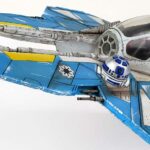

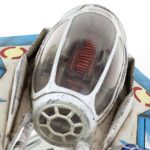


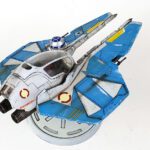



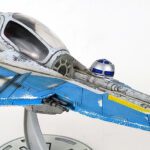


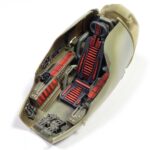
Leave a Reply